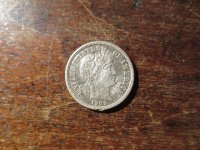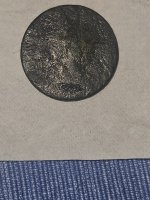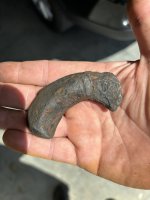Badger Bart
Sr. Member
- Mar 24, 2005
- 301
- 18
Jean Lafitte - Barrataria Corsair
Between 1803 and 1814 Lafitte owned and operated a tremendous business which transported merchandise of all kinds from a number of markets within the city and to and from various designated spots south of it. Gold, jewels, slaves, beef, commodities of all sorts. During much of that period he operated from the Neutral Strip. This "Neutral Ground Agreement" was a treaty negotiated in 1806 between Spanish General Simon Herrera and American General James Wilkinson, and remained in effect until 1821.The strip was unoccupied by military troops or law enforcement from either nation, so naturally it soon became a notorious refuge for the lawless desparados of both nations. Be it corsair, buccaneer, freebooter, sea dog or picaroon, piracy is still the game, and such could ask for no better haven to practice their trade than this Strip in southwest Louisiana. Although a few legitimate land hunters had settled there, including some small bands of Attakapas Indians, the majority of inhabitants were undoubtedly pirates.
Bound on the west by the Sabine River, and on the east by the Calcasieu, or Arroyo Hondo, this region holds as many or more legends of buried treasure than anywhere else in the world. While some treasure has unquestionably been recovered by Lafitte's pirates or their descendants, I have no doubt that some substantial caches remain undiscovered to this day. One particular legend regarding Lafitte was his secret mission to remove Napoleon Bonaparte and his personal fortune from Europe before his capture and confinement to Elba. This legend insists that Lafitte waited off the coast for the deposed Emperor, after his personal fortune had been loaded onto Lafitte's ship, until the appointed time time for Napolean himself to appear and board had long past. Forced to sail to save himself, his ship and crew, he is said to have made straight for the Strip in Louisiana. If that were the end of this particular legend, one could easily write it off as romantic imaginings by old men with nothing better to do than spin campfire yarns. I believe otherwise.
It is known that several of Lafitte's crew became settlers in the Strip and surrounding areas. Old pirates don't all just sail off into the sunset never to be heard from again. Many of their stories have been recorded and re-told, the stuff of today's legends. Naming some of them is easy, Pierre Guilotte, Charles Conea, Henry perry, Henri Nunoz, and Captain Arsene LeBleu had all sailed on Lafitte's ships before becoming settlers. LeBleu became a rancher and cattle buyer at the point where the Calcasieu intersected with the Old Spanish Trail, building a cabin there as early as 1815.
One of the oldest legends is told by descendants of Charles Sallier, a French aristocrat who escaped to Spain, from whence he paid Lafitte an outrageous sum to resettle him in Louisiana. Sallier is said to have bartered trinkets to the Indians for land, building his home on Barb Shellbank, today known as Money Hill. This home was later moved to Lake Charles.
It is said that a score of sea chests was loaded aboard Lafitte's ship one night, Napoleon's personal fortune. Napoleon hoped to escape his fate in Europe after Waterloo by relocating to Louisiana, but when he failed to board the ship at the appointed time, Lafitte was forced to sail without him. Some reliable historical figures proclaim this to be true. So what became of this score of sea chests you ask? It promptly arrived at Barb Shellbank in front of Sallier where the ship dropped anchor. Lafitte and crew enjoyed a week- long riotous spree of food, wine, and good American beef.
The ever unpredictable Lafitte then sailed off during the night, anchored downstream, and buried Napoleon's sea chests in the marsh. No doubt searched for countless times, it apparently has never been found. Certainly one can surmise that had this treasure been found, some of it could easily be linked directly to Napleon, identifiable, and possibly recorded before it left Europe. Hope remains as eternal as the legends, and fuels the treasure hunter's heart to find this or other caches of the famed Lafitte.
Between 1803 and 1814 Lafitte owned and operated a tremendous business which transported merchandise of all kinds from a number of markets within the city and to and from various designated spots south of it. Gold, jewels, slaves, beef, commodities of all sorts. During much of that period he operated from the Neutral Strip. This "Neutral Ground Agreement" was a treaty negotiated in 1806 between Spanish General Simon Herrera and American General James Wilkinson, and remained in effect until 1821.The strip was unoccupied by military troops or law enforcement from either nation, so naturally it soon became a notorious refuge for the lawless desparados of both nations. Be it corsair, buccaneer, freebooter, sea dog or picaroon, piracy is still the game, and such could ask for no better haven to practice their trade than this Strip in southwest Louisiana. Although a few legitimate land hunters had settled there, including some small bands of Attakapas Indians, the majority of inhabitants were undoubtedly pirates.
Bound on the west by the Sabine River, and on the east by the Calcasieu, or Arroyo Hondo, this region holds as many or more legends of buried treasure than anywhere else in the world. While some treasure has unquestionably been recovered by Lafitte's pirates or their descendants, I have no doubt that some substantial caches remain undiscovered to this day. One particular legend regarding Lafitte was his secret mission to remove Napoleon Bonaparte and his personal fortune from Europe before his capture and confinement to Elba. This legend insists that Lafitte waited off the coast for the deposed Emperor, after his personal fortune had been loaded onto Lafitte's ship, until the appointed time time for Napolean himself to appear and board had long past. Forced to sail to save himself, his ship and crew, he is said to have made straight for the Strip in Louisiana. If that were the end of this particular legend, one could easily write it off as romantic imaginings by old men with nothing better to do than spin campfire yarns. I believe otherwise.
It is known that several of Lafitte's crew became settlers in the Strip and surrounding areas. Old pirates don't all just sail off into the sunset never to be heard from again. Many of their stories have been recorded and re-told, the stuff of today's legends. Naming some of them is easy, Pierre Guilotte, Charles Conea, Henry perry, Henri Nunoz, and Captain Arsene LeBleu had all sailed on Lafitte's ships before becoming settlers. LeBleu became a rancher and cattle buyer at the point where the Calcasieu intersected with the Old Spanish Trail, building a cabin there as early as 1815.
One of the oldest legends is told by descendants of Charles Sallier, a French aristocrat who escaped to Spain, from whence he paid Lafitte an outrageous sum to resettle him in Louisiana. Sallier is said to have bartered trinkets to the Indians for land, building his home on Barb Shellbank, today known as Money Hill. This home was later moved to Lake Charles.
It is said that a score of sea chests was loaded aboard Lafitte's ship one night, Napoleon's personal fortune. Napoleon hoped to escape his fate in Europe after Waterloo by relocating to Louisiana, but when he failed to board the ship at the appointed time, Lafitte was forced to sail without him. Some reliable historical figures proclaim this to be true. So what became of this score of sea chests you ask? It promptly arrived at Barb Shellbank in front of Sallier where the ship dropped anchor. Lafitte and crew enjoyed a week- long riotous spree of food, wine, and good American beef.
The ever unpredictable Lafitte then sailed off during the night, anchored downstream, and buried Napoleon's sea chests in the marsh. No doubt searched for countless times, it apparently has never been found. Certainly one can surmise that had this treasure been found, some of it could easily be linked directly to Napleon, identifiable, and possibly recorded before it left Europe. Hope remains as eternal as the legends, and fuels the treasure hunter's heart to find this or other caches of the famed Lafitte.



 This is of interest to me, also; War of 1812, Gen. Jackson, Lafitte Bros...
This is of interest to me, also; War of 1812, Gen. Jackson, Lafitte Bros... 




